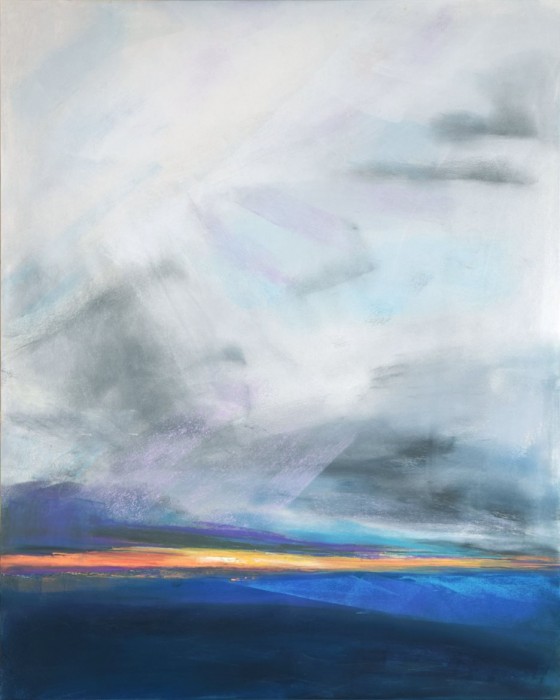Susan Solomon’s paintings are saturated, evocative, and striking, and we’re so pleased to have her as our featured artist for 41.2. We were immediately struck by the emotional resonance of these paintings. Art Editor Cade Leebron got in touch with Susan to ask her a few questions about her series, “Flight.”
Cade Leebron: These paintings are so beautiful! I was drawn to these immediately for their rich colors, which are so luminous. Could you talk a bit about your painting process, and the color choices you made in this set of paintings?
Susan Solomon: Thank you! I grew up in Las Vegas, a city of gorgeous hallucinogenic sunsets and, of course, all that crazy neon. I am sure this influenced my color sense, as well as a need for endless space, which is what you find in the desert. I am never quite sure how to answer the “process” question since I did not take the Creative Process class when it was offered! But, all the pieces in this Flight series are pastel on panels. Whenever I fly, I sit in the window seat and take mental notes and hundreds of pictures of the view. And thank you for saying the work is “luminous.” I originally wanted to be a stained glass artist but was afraid of gettinghurt, so have spent my art life trying to capture that luminosity with other materials. Georges Rouault is my favorite painter, the artist whose work moves me like no other, and he started out as a stained glass apprentice.

CL: You said in your artist statement that you were “impressed time and again by how little literal imagery is necessary in a painting for a viewer to create a complete narrative.” With that in mind, I’m interested in the painting here that does have the most literal imagery (“Winged Flight”), and how the process of creating a painting with literal imagery differs for you.
SS: It is all painting, so the basic elements of art, and the foundations that make up a successful piece still apply. Composition, angles, proportion, and values (lights and darks) are still key. Of course, if you paint an animal or a person, it better resemble them, but the thinking is the same: lights, darks, shapes, angles, measuring one mark against another.

CL: All the paintings in this set have a representation of a horizon. Could you tell me about the use of horizons in your work? Is this an image you explore often?
SS: You read paintings well! Yes, I am very much interested in the placement of the horizon, or the lack of it, in a piece. Poet Deborah Keenan, who I have the honor of working with, wrote about a man who blocked out his horizon line by planting trees, and that is a very interesting and somewhat disorienting thought. I also oftenreturn to Giorgio Morandi’s paintings and the way he plays with lost and found horizon lines and the tension that creates. In pieces like these pastels, I tend to think of the horizon lines not so much as horizon, but more as a compositional aspect. Other pieces which are influenced by Asian art have no horizon line at all, which changes the narrative in beautiful ways.

CL: I also saw on your website that you sometimes create work in collaboration with poets, “painting their poems and stories.” I’m so curious about those collaborations, and whether any of these paintings arose in a similar fashion. I was also struck by your statement that “the poets have the final say on whether the paintings are successful impressions of their words.” How has that worked out in the past?
SS: It is beyond inspirational working with writers, and their words and thoughts definitely offer endless “prompts” and images I never would have conjured up if left to my own devices. In one of Deborah Keenan’s MFA poetry classes, she told us to read a poem and then wake up at midnight to see what impression the poem has left you with. I often take that advice, read a piece, then think about it hours later. I do not illustrate poems, but try to paint the impressions they leave. There have been times when the writers vetoed a painting, and on every occasion I have listened to them, redid the piece and came up with something better.

CL: You’ve said that your paintings “represent internal and external landscapes and the relationship between the two.” Looking at these images, I definitely had a sense of their emotional power. How does the desire to evoke those internal landscapes affect your process?
SS: Oh, the process question, which always stumps me. I think I just see the world in a certain way, and that is what keeps appearing. There is a quiet brightness I aim for, even in the midst of darkness. I once had a painting teacher, Murray Dessner, who said that the best painters know how to paint the darks, and that really stuck with me.

CL: Given the current climate, and the potential cuts to funding for artistic endeavors, how are you conceptualizing your future as an artist moving forward?
SS: I could paint political art; some of Dr. Seuss’ best art was his political art, which is 100% timely! I live in the beautiful blue state of Minnesota, which gives more money to the arts than any state other than NY. The cuts will be devastating to many people financially in terms of jobs, and culturally to our country. Because really, what is important to us and what do we stand for besides war and racism? Personally, government funding does not play too much of a direct role in my artistic endeavors. But this current time is definitely a terrible page in our history and if we survive it, then we truly are a great country.
Susan Solomon is a freelance paintress living in the beautiful Twin Cities of Minneapolis Saint Paul.
